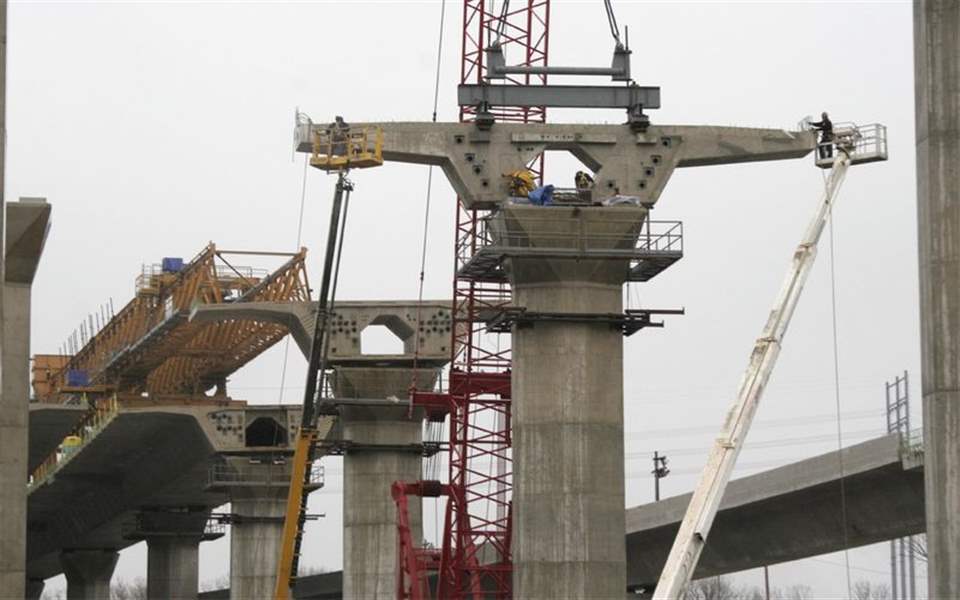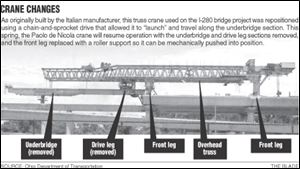
Work on main span will begin in spring
1/15/2005
Construction crews using ground-based cranes hoist one of the segments of the new I-280 bridge to its pier-top position.
long / blade

Construction crews using ground-based cranes hoist one of the segments of the new I-280 bridge to its pier-top position.
Main-span assembly of the new I-280 bridge over the Maumee River will begin this spring using three trusses, including one that will use components from a gantry crane previously banished from the project, the Ohio Department of Transportation and its contractor announced yesterday.
The construction will close I-280 to through traffic for seven months, starting in May. But that will be at least five months faster than if contractor Fru-Con Construction Corp. of Ballwin, Mo., were to use just two trusses instead of three, Rich Martinko, an ODOT assistant director in charge of the $220 million project, said during a news conference yesterday.
"This is the most productive and most risk-free plan to complete the main spans and complete the project," Mr. Martinko said. "We strongly believe this plan is in the best interests of worker safety and the safety of the traveling public, and it provides the most practical solution to complete the project."
The plan is intended to enable Fru-Con to finish construction on time, in October, 2006, despite two accidents that have put main-span construction on hold for 11 months and counting. The first accident, a Feb. 16 collapse of a horizontal truss crane, killed four construction workers and injured four more.

One of the trusses to be used will be a gantry crane similar in design to equipment being used to build ramp spans on the I-280 project and became available with the recent completion of a bridge project in Malaysia, said David Herron, the project director for Fru-Con.
Another is an "underslung" truss - not a crane at all, but rather a scaffold that will be hung between bridge piers to support precast span segments during assembly - that is being custom-built in Texas, Mr. Herron said.
But the third will be the truss portion of a crane identical to the one that crumpled to the ground last year during repositioning, and which was itself involved in a minor accident Oct. 23 during an attempt to resume construction.
A federal investigation of the Feb. 16 accident faulted Fru-Con for failing to ensure that the crane involved was properly secured to the completed portion of the bridge while it was being repositioned to start work on a new span. Fru-Con is appealing that finding and a subsequent $286,000 fine.
The fallen crane's twin was modified to improve its stability, but during the first post-collapse repositioning one of its support legs fell out. While an investigation of that accident continues, Fru-Con reported that a wiring error caused a winched cable controlling the leg to overload and snap. No one was hurt.
Mr. Martinko and others said after the October incident the big yellow crane would be removed and dismantled, but officials said yesterday that without the innovative "self-launching" system in use during both accidents, the device now resembles traditional construction gantries that have been used on numerous bridge projects throughout the world.
Joe Blaze, business manager for Ironworkers Local 55, the union representing all four of the men killed in February, said he is satisfied that the simplified crane can be used safely.
"It's a little more of a traditional [construction] method," he said after the news conference. "It eliminates the self-launching procedure, which we're happy about."
The "self-launching" system was developed to allow crane work, including repositioning, to occur without interrupting traffic on existing I-280, over which much of the bridge is being built. But state officials declared after the first crane accident that they would no longer allow such work to be done over traffic.
Mr. Herron said Fru-Con expects to have all three trusses on-site by late March and in operation by late May. At that time, a sequence of closings will affect traffic on I-280 through year's end.
During the first three months, traffic will be blocked for weeks at the Front Street interchange in East Toledo while bridge spans are assembled overhead.
But the main blockage will be in North Toledo, where I-280 will be closed between Summit Street and Greenbelt Parkway for about six months, starting in early summer.
I-280 through traffic will be directed to use I-75 and State Rt. 795, while traffic headed for Oregon points will be detoured from I-75 to Miami, Fassett, and Oak streets, Woodville Road, and Navarre Avenue, and Cedar Point traffic will be urged to use the Ohio Turnpike from I-75.
Contact David Patch at:
dpatch@theblade.com
or 419-724-6094.